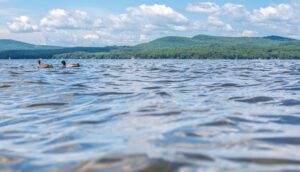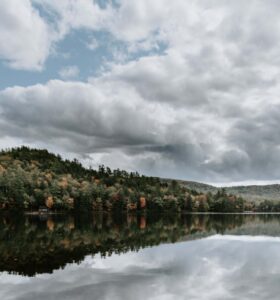Return on investment: Making the business case for conserving watersheds

A research team working with Sebago Clean Waters lays out the benefits and costs of conserving forestland to protect drinking water and other values.
October 2021
For every dollar invested in conserving forestland in the Sebago Lake watershed in southwestern Maine, at least eight dollars in benefits comes back in return.
That is one of the key findings of recent research that weighed the benefits and costs of conserving forestland in the 235,000-acre watershed, which provides drinking water to more than 200,000 people in the greater Portland region—about one in six Mainers.
The research was commissioned by Sebago Clean Waters (SCW), a coalition of land trusts, conservation organizations, and the Portland Water District with a mission “to protect water quality, community well-being, a vibrant economy, and fish and wildlife habitat in the Sebago watershed through voluntary forestland conservation.” Adam Daigneault, Spencer Meyer, Tamara Lee Pinard, and Aaron Strong collaborated on the research. The results were published in a 2021 paper in the journal Ecosystem Services and in an earlier report to SCW.
Daigneault is an associate professor in the School of Forest Resources at the University of Maine and a Mitchell Center faculty fellow. Meyer leads the conservation finance program at the Highstead Foundation, an SCW partner. Lee Pinard is the community initiatives manager at The Nature Conservancy (TNC), also an SCW partner. Aaron Strong is a former UMaine faculty member who now teaches at Hamilton College in New York.
Efforts to conserve land in the watershed, which stretches from Standish to Bethel, are not new—land trusts and the Portland Water District (PWD) have been protecting land for many years. But the collaboration among the SCW partners is ramping up these conservation efforts, multiplying their impact and reach, notes Lee Pinard.
What’s at stake
“The forest is our natural filter,” says Kirsten Ness, water resources specialist for PWD, in a video on the SCW website.
Sebago Lake water is exceptionally clean and pure, thanks to the natural filtration provided by the forests that currently make up about 84% of the surrounding watershed. To meet the drinking water quality standards set by the U.S. Environmental Protection Agency (EPA), most water sources need to be filtered as a first step in the water treatment process before being delivered to people’s taps. Only 50 or so sources in the U.S. qualify for a waiver from this filtration requirement. Sebago Lake is one of them.
 Increasing development in the Sebago Lake watershed, however, threatens the region’s drinking water quality, and the federal filtration waiver. Most of the watershed—about 88%—is privately owned and therefore could potentially be developed, says Paul Hunt, environmental manager with PWD. A 2009 report by the U.S. Forest Service identified the watershed as the third most vulnerable drinking water supply in the Northeast due to development pressure on private forestland.
Increasing development in the Sebago Lake watershed, however, threatens the region’s drinking water quality, and the federal filtration waiver. Most of the watershed—about 88%—is privately owned and therefore could potentially be developed, says Paul Hunt, environmental manager with PWD. A 2009 report by the U.S. Forest Service identified the watershed as the third most vulnerable drinking water supply in the Northeast due to development pressure on private forestland.
Hunt notes that development will happen, but it needs to be balanced by conserving forests to protect water quality and all the other benefits forests provide. One way to think about these benefits is as “ecosystem services,” which include cleaner air, wildlife habitat, reducing the amount of carbon dioxide in the atmosphere, and outdoor recreation opportunities.
Currently only about 12% of the watershed is permanently conserved. Sebago Clean Waters has embarked on a campaign to protect 25% of the watershed in total (an additional 30,000 acres) as forestland by 2035.
An ounce of prevention is worth a pound of cure
Sebago Clean Waters decided to create a “water fund” for the Sebago Lake watershed as a tool for encouraging and directing investment in watershed conservation. A water fund is a financial vehicle that enables downstream water users to invest in protecting the upstream forests that protect their water source.
Through early outreach to businesses, landowners and other constituents, SCW realized that to make a strong case for investing in the Sebago Clean Waters Fund, they needed to raise awareness about Sebago Lake and all the benefits the watershed provides, as well as its vulnerability.
Tamara Lee Pinard notes that in many places where water funds have been created, local water districts are trying to restore degraded sources by fixing problems, such as an overgrowth of algae or pollution from agricultural runoff. But in the Sebago Lake watershed, the challenge is about keeping a water supply clean, rather than fixing a problem once it’s happened. “We actually have really good water that we want to keep that way,” she says. “So how do you convince people that it’s urgent and they need to get involved?”
The SCW partners recognized that one thing they needed was good storytelling, and another was solid data on the ecological and economic aspects of conserving forestland in the watershed, says Lee Pinard. Utilizing the diverse expertise, resources and networks among the partners, they created an informative and engaging website to help tell the story. And, with funding from TNC and the Highstead Foundation, Lee Pinard and Meyer approached Adam Daigneault and the Mitchell Center about collaborating on an assessment of the economic benefits and costs of scaling up conservation in the watershed.
Both Lee Pinard and Meyer already had strong connections with the Mitchell Center, so the collaboration was a natural fit. Meyer completed his Ph.D. at UMaine working on a Mitchell Center project that combined land use planning, natural resource management and conservation, including in the Sebago Lake watershed. Daigneault had been working with Lee Pinard and TNC on a study of economic and community resilience in Maine’s Katahdin region, funded in part by the Mitchell Center. Lee Pinard and Meyer knew that Daigneault had the expertise and on-the-ground knowledge to assemble a team to do the research, and put it in context for Maine.
The research team used current information on land use, ecosystem services valuation, and conservation practices to estimate the potential benefits and costs of conserving forestland in the Sebago Lake watershed, under a range of assumptions and scenarios.
“If we can take a percentage of the cost of building a filtration plant and invest those funds in forestland conservation instead, we might avoid that larger cost for another 20 years, 40 years, 60 years, 100 years—maybe forever. That’s another thing that this study was able to show.”
–Paul Hunt, Portland Water District
Crunching the numbers
The research found that if the area of forest cover in the Sebago Lake watershed is reduced from the current level of 84% to about 76%, the water quality of streams, rivers and wetlands, and eventually Sebago Lake itself, could be degraded.
“We’d never had that number before, what I call the tipping point,” says Paul Hunt. “Before this research, we had an estimate of around 70%, looking at studies done elsewhere. But Adam and his team were able to refine that number, and it’s even more powerful because they used data from this watershed.”
If the water quality in Sebago Lake decreases to the point where it no longer qualifies for a filtration waiver, Portland Water District would need to build a filtration plant to replace what the forest now does naturally. Working with PWD, the researchers estimated that it would cost about $150 million dollars to construct a filtration plant, plus annual operating costs. This could lead to a 42-82% increase in costs to ratepayers.
“If we can take a percentage of the cost of building a filtration plant and invest those funds in forestland conservation instead, we might avoid that larger cost for another 20 years, 40 years, 60 years, 100 years—maybe forever,” says Paul Hunt. “That’s another thing that this study was able to show.”
And protecting water quality is just one way that investing in forests generates returns. The study also estimated that the total value of the ecosystem services provided by forestland in the Sebago Lake watershed could range from $42-$287 million, or $219-$1,486 per acre, each year.
Beer, bread, coffee, farms and more
 One industry that relies heavily on Sebago Lake’s pristine water is the Portland area’s growing craft brewing sector. Several area breweries have joined SCW’s efforts and actively support the coalition’s work, including by donating a small amount to SCW for every barrel of beer brewed.
One industry that relies heavily on Sebago Lake’s pristine water is the Portland area’s growing craft brewing sector. Several area breweries have joined SCW’s efforts and actively support the coalition’s work, including by donating a small amount to SCW for every barrel of beer brewed.
At the beginning of a 2019 film produced by SCW and the Maine Brewshed Alliance, the filmmakers ask a group of Maine brewers what the most important ingredient is in good beer. Heather Sanborn of Rising Tide Brewing Company says, “It’s got to be the water.”
Other Portland-area businesses also realize the value of the resource. Coffee by Design, one of Maine’s premier coffee businesses, is featured in a video on the Sebago Clean Waters website that lays out why the purity of Sebago Lake water is crucial for businesses and people alike. Scratch Baking Company and Cultivating Community are also highlighted.
Sebago Clean Waters finds ongoing value in the study as the partners continue outreach to businesses, organizations, residents and landowners, says Lee Pinard. “We keep going back to this study because it lays out not just the value of conserving forests for drinking water quality, but air quality and climate resilience as well. It looks at the multiple layers of ecological value and the economics around that.”
Progress and plans
In September 2020, SCW was awarded an $8 million USDA grant to further their work by supporting forest conservation, land stewardship, stream connectivity, and landowner outreach. The coalition is using these funds to leverage another $10.5 million from public and private sources.
“USDA reviewers cited our work on the connection between watershed conservation and community social and economic benefits as one reason our proposal, the second largest of only ten awards in the U.S., was successful,” says Spencer Meyer. “Our collaboration with the Mitchell Center has really helped us communicate the value of Sebago Clean Waters to our stakeholders.”
Resources and Updates:
Project report: An Economic Case for the Sebago Watershed Water and Forest Conservation Fund
Learn more about a subset of land that’s been protected in the Sebago Lake watershed in partnership with Portland Water District, and the benefits generated by these conservation efforts, in Forever Forests for Sebago Lake, a Story Map created by PWD.
Learn more about water funds and source water protection in A Natural Solution to Water Security from The Nature Conservancy.
Learn more about the connections between beer and Maine’s watersheds in a May 2021 feature on NewsCenter Maine.
